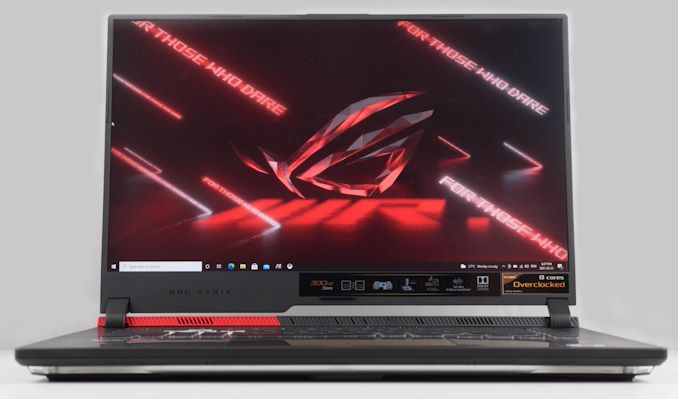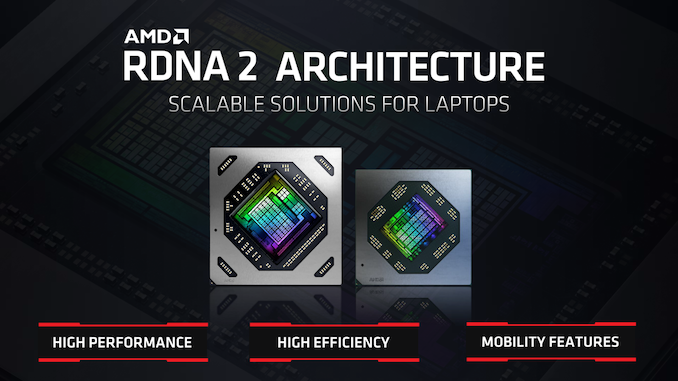The ASUS ROG Strix G15 (G513QY) Review: Embracing AMD's Advantage
by Brett Howse on May 31, 2021 11:00 PM EST
The 1989 film Field of Dreams offers one of the most memorable quotes in movie history. “If you build it, he will come” was, of course, a reference to a baseball diamond in Iowa, but for AMD, this same quote (gender removed) also succeeds in defining AMD’s success over the last couple of generations. Once the realm of budget-conscious devices, AMD-based products are now the premium in the market and are sought after by consumers looking for the ultimate in performance. With the launch of the Zen 3 based Cezanne laptop processors, AMD now offers the most powerful laptop CPUs available. But that is only a single portion of a successful product. AMD is today announcing the launch of their latest graphics architecture, RDNA2, into the laptop market. AMD has built it. Now they must see who will come.
ASUS has partnered with AMD to launch a premium gaming laptop based on AMD’s Cezanne and RDNA2 solutions. The ASUS ROG Strix G15 AMD Advantage Edition (G513QY) offers the top-tier experience that AMD customers have been asking for, with a great design, and powerful internals. The ASUS Strix featured today is outfitted some with the very best that AMD has to offer, with the AMD Ryzen 5900HX processor, and AMD Radeon RX 6800M graphics. Zen 3 with RDNA2 is a potent combination. The Ryzen 5900HX is an eight-core, sixteen thread processor with a maximum boost frequency of 4.6 GHz, and a 45-Watt TDP. The Raden RX 6800M is AMD’s latest GPU architecture with 40 Compute Units, 12 GB of GDDR6, and up to 145 Watts. With 16 GB of DDR4 and a 512 GB SSD, this 15.6-inch device packs a lot of punch.
| ASUS ROG Strix G15 AMD Advantage Edition (G513QY) |
|
| Component | Strix G513QY |
| CPU | AMD Ryzen 9 5900HX 8-Core 16-Thread 3.3-4.6 GHz Vega 8 / 2100MHz 45W TDP |
| Discrete GPU | AMD Radeon RX 6800M 40 RDNA2 Compute Units 2300 MHz Game Clock 96 MB Infinity Cache 12GB GDDR6 |
| Display | 15.6-inch 1920x1080 IPS 300Hz Refresh FreeSync sRGB Gamut Optional: 15.6-inch 2560x1440 IPS 165 Hz Refresh FreeSync P3-D65 Gamut |
| RAM | 16GB DDR4-3200 Dual-Channel Upgradable Memory |
| Storage | 512GB M.2 PCIe SSD 2 x M.2 (1 free) |
| Network | MediaTek MT7921 Wi-Fi 6 2x2:2 802.11ax Realtek Gigabit Ethernet |
| Left Side | 2 x USB 3 Type A Headset Jack |
| Right Side | No Ports |
| Back | Power Connector HDMI 2.0b USB Type-C w/100W PD USB 3 Type-A |
| Battery | 90Wh Lithium Ion 280W AC Adapter |
| Dimensions | 355 x 260 x 20.7 mm 14 x 10.2 x 0.81 inches |
| MSRP | $1550 - $1700 |
AMD has certainly struggled in the past to land design wins in the premium end of the market, but with new products come new opportunities, and it appears that those days are behind them. The tight product integration of processor and graphics is certainly a benefit that their competition does not yet enjoy. AMD has never really captured much of the gaming laptop segment but is clearly aiming to remedy that with this launch. AMD says that the Radeon RX 6800M should be able to compete with the NVIDIA GeForce RTX 3080L, which will put them in a much better light than the previous mid-range market they targeted before. Coupling that with their Cezanne platform makes for a very strong combination. It also explains their effort to add Wi-Fi to the mix as Intel uses that as a key component of their platform.
As a proper gaming system, the 1920x1080 IPS display offers a refresh rate of 300 Hz, and is coupled with AMD’s FreeSync variable refresh rate technology. There is Wi-Fi 6, courtesy of MediaTek, and for expansion, there are three USB Type-A ports, and a single Type-C on the rear, which can deliver up to 100 watts of power delivery. For video out, ASUS has gone with a single HDMI port as well as DisplayPort via USB-C, and of course there is a headset jack. What is missing though is a webcam of any sort, which is an odd omission in today’s remote world.
The ASUS ROG Strix G513QY packs into this 15.6-inch chassis, without the device seeming heavy or bulky, especially by gaming notebook standards. First up, let’s take look at the design.













146 Comments
View All Comments
eva02langley - Tuesday, June 1, 2021 - link
Not interested into anything not 1440p, IPS, 144Hz, top color accuracy and Freesync... AMD promised that on stage yesterday... WTH does Asus smoke...!!!???eva02langley - Tuesday, June 1, 2021 - link
Even you guys admit that ASUS SCREWED up not going 1440p. How awesome... ASUS was already on my blacklist for the disaster the G73JH-A1 was... but this is just ridiculous, they are joke as system implementer. They proved it by their incompetence."AMD targets the Radeon RX 6800M at 2560x1440, and for good reason. As we have seen, in pretty much every title, it is completely CPU bound at 1920x1080, even with the newest Ryzen 9 5900HX as the processor. The synthetic tests, as well as the UHD resolution results, really prove this point.
Although there is certainly a market where the 1920x1080 resolution is desired for the lowest latency, in this system, that panel is really too low of a resolution for such a powerful GPU, and it becomes wasted money spent."
eva02langley - Tuesday, June 1, 2021 - link
Well, i just realized that there is a 1440p panel also... however this 1080p version should not even exist. A 1440p panel resolution can be scaled to 1080p if required... so what is the point? 300Hz??? In optimal gaming scenario at 300Hz constant, you gain 4ms of response.As a comparative, 4ms is the equivalent of ONE FPS.... from 250Hz-251Hz... only idiots will defend this stupidity.
eva02langley - Tuesday, June 1, 2021 - link
Ah, I made a mistake in the calculation. The difference is more in the realm of 50 FPS at a 120Hz basis. So basically, 120Hz to 170Hz is the same amount of time from 144Hz to 300Hz.Makes more sense. But still, 50Hz from 120Hz is worth the same than 144Hz to 300Hz. Meaning those 50Hz are worth those 156Hz. This is because FPS are not a linear factor and a ratio.
Spazosaurus - Tuesday, June 1, 2021 - link
Perhaps the next generation of gpus will have enough power to render even the most demanding titles at 2k60 baseline, at which point I'll happily embrace 2k laptop displays. Native 1080p,to me, looks much better than 1080p on a 2k display. Personally I prefer a lower res native display so that I can crank up the quality settings. Once I'm over 60fps, it does not matter if I'm cpu bound or not. I'm not going to lower a native 2k display to 1080p to get 60fps.Spunjji - Friday, June 4, 2021 - link
This GPU isn't going to have any problems rendering any modern titles in 1440p at more than 60fps - at least, not unless you use RT...DanaGoyette - Tuesday, June 1, 2021 - link
I initially thought: ooh, real home, pageup, pagedown, and end keys... But nope, the right column is media playback control keys, and those text cursor control keys are hidden behind Fn.I guess I'm sticking with my HP Omen.
Pacinamac - Tuesday, June 1, 2021 - link
Competition is the best thing for the consumer. Doubt I'll get an AMD system (I'm a video editor who uses quicksync) but happy to see them doing so well.jenesuispasbavard - Tuesday, June 1, 2021 - link
I'm confused with these GPU tests. Comparisons to the competition at only 1080p? Only this laptop's performance at 4K (no comparisons)? 3DMark Fire Strike - which is *eight* years old now; and no Time Spy or Port Royal? 3DMark total score and not GPU score?ksec - Tuesday, June 1, 2021 - link
Why did they not call it Amdvantage is beyond me.